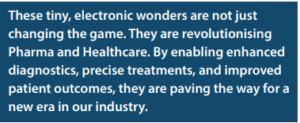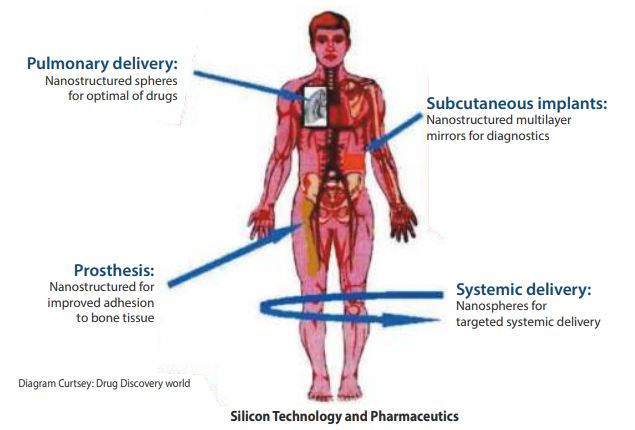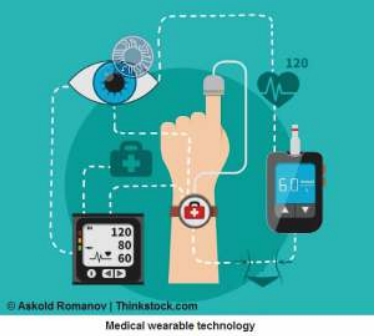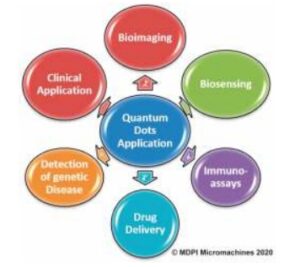The pharmaceutical and healthcare industry is experiencing a transformative shift in today’s digital age. Nanostructures may be used to deliver drugs where they are required. Innovative drug delivery systems, wearables, advanced imaging systems, medical devices, etc, have become integral to patient care, diagnosis, and treatment. Behind the scenes of these cutting-edge innovations lies a crucial component that powers their functionality: SILICON (Si).
Nanostructures may be used to deliver drugs where they are required to avoid harmful side effects. The recent discovery that following Nano-structured silicon can be rendered biocompatible and  biodegradable has far-reaching and profound long-term implications for the pharmaceutical industry and medicine. Drug particles are structured within Nano-width pores of silicon particles, giving controlled release/improving the solubility of hydrophobic drugs. Merits of porous silicon in drug release kinetics and drug loading efficiency, as well as being a part of its localized chemotherapy program, also demonstrate optical properties that provide the basis for various potential devices for biodegradable and biocompatible diagnostic products. Nano-structured porous silicon offers new ways to address hydrophobic and low bioavailable drugs. It is being applied in a wide range of healthcare products, directly impacting patient care and outcomes. Anti-cancer therapeutics have been successfully incorporated into porous Silicon. Large pores are desirable when incorporating sizable molecules or drugs within the pores. Smaller pores provide more surface area and expose more sites for attack of aqueous media. Silicon’s role in electronic devices is not just about being a component. It is about its unique properties as a semiconductor. Silicon, transformed into a pure, flawless crystal through sophisticated production techniques, is the key semiconductor material that powers our digital world. This silicon element conducts electricity more than an insulator, such as glass or ceramics, but less than a pure conductor, like copper or aluminium. Its conductivity and other properties can be altered by introducing impurities, called doping, to meet the specific needs of the electronic component in which it resides.
biodegradable has far-reaching and profound long-term implications for the pharmaceutical industry and medicine. Drug particles are structured within Nano-width pores of silicon particles, giving controlled release/improving the solubility of hydrophobic drugs. Merits of porous silicon in drug release kinetics and drug loading efficiency, as well as being a part of its localized chemotherapy program, also demonstrate optical properties that provide the basis for various potential devices for biodegradable and biocompatible diagnostic products. Nano-structured porous silicon offers new ways to address hydrophobic and low bioavailable drugs. It is being applied in a wide range of healthcare products, directly impacting patient care and outcomes. Anti-cancer therapeutics have been successfully incorporated into porous Silicon. Large pores are desirable when incorporating sizable molecules or drugs within the pores. Smaller pores provide more surface area and expose more sites for attack of aqueous media. Silicon’s role in electronic devices is not just about being a component. It is about its unique properties as a semiconductor. Silicon, transformed into a pure, flawless crystal through sophisticated production techniques, is the key semiconductor material that powers our digital world. This silicon element conducts electricity more than an insulator, such as glass or ceramics, but less than a pure conductor, like copper or aluminium. Its conductivity and other properties can be altered by introducing impurities, called doping, to meet the specific needs of the electronic component in which it resides.
 In 1874, Karl Braun discovered and documented the first semiconductor diode effect. Silicon is the most used semiconductor for discrete devices and integrated circuits, unlike germanium. Semiconductors are divided into two types: intrinsic semiconductors and extrinsic semiconductors. Intrinsic semiconductors are pure semiconductors, and these are substances without the presence of any impurity or doping. Extrinsic semiconductors are prepared by adding enough impurities. Extrinsic semiconductors have a much higher electrical conductivity than their intrinsic counterparts. That is the main aim behind the doping
In 1874, Karl Braun discovered and documented the first semiconductor diode effect. Silicon is the most used semiconductor for discrete devices and integrated circuits, unlike germanium. Semiconductors are divided into two types: intrinsic semiconductors and extrinsic semiconductors. Intrinsic semiconductors are pure semiconductors, and these are substances without the presence of any impurity or doping. Extrinsic semiconductors are prepared by adding enough impurities. Extrinsic semiconductors have a much higher electrical conductivity than their intrinsic counterparts. That is the main aim behind the doping  process – to create N and P-type semiconductors that, when used together, increase conductivity considerably. The temperature will also affect electrical conductivity. Semiconductors are essential for therapeutic medical devices because they provide the power, precision, and reliability needed to deliver safe and effective treatment.
process – to create N and P-type semiconductors that, when used together, increase conductivity considerably. The temperature will also affect electrical conductivity. Semiconductors are essential for therapeutic medical devices because they provide the power, precision, and reliability needed to deliver safe and effective treatment.
I. Advancements in semiconductor technology
II. The Role of Silicon Semiconductors in Pharma and Healthcare
Semiconductors are essential components in ‘Drug delivery technology’ and ‘Medical devices’. Semiconductors are the central processing units responsible for data acquisition, analysis, and transmission. Semiconductors have created innovative products that effectively detect, diagnose and treat various medical conditions. Semiconductors are crucial in creating more advanced pharma and medical devices such as –
Drug Delivery Systems
Semiconductors have revolutionised drug delivery by making it possible to develop more personalised, controlled, and wireless drug delivery systems. These systems are helping to improve patient outcomes and reduce the risk of side effects. Personalised drug delivery systems can be programmed to release medication at specific times and in specific doses. It can help to optimise therapeutic outcomes and minimise side effects. For example,
• a patient with diabetes may need to receive insulin at different times of the day, depending on their blood sugar levels. A person could program a personalised drug delivery system to release insulin at the appropriate times, which could help keep the patient’s blood sugar levels safe.
• Semiconductors are used in drug delivery to create controlled-release systems. These systems can release medication over a period of time, which can help to improve patient compliance and reduce the risk of overdose. For example, a patient with hypertension may need to take blood pressure medication every day. Patient can use a controlled-release drug delivery system to release the medication over a 24-hour period and reduce the risk of overdose.
• Semiconductors are being used to create wireless drug delivery systems. These systems can communicate with healthcare providers in real-time, which can help to ensure that patients receive the correct dose of medication at the correct time. For example, a cancer patient may receive chemotherapy through a wireless drug delivery system. The system could send data to the patient’s healthcare provider about how much medication has been delivered and how the patient responds to the treatment. This information could help the healthcare provider to adjust the treatment plan as needed.
• Implantable pumps that deliver medication directly into the bloodstream.
• Transdermal Patches that deliver medication through the skin.
• Polymeric nanoparticles that deliver medication to specific cells or tissues.
As semiconductor technology continues to evolve, we can expect to see even more sophisticated and innovative drug-delivery systems in the future.
Silicon Technology and Pharmaceutics
 Nanostructure science and technology is the design, fabrication, understanding and use of materials at length scales between 1 and 100 nanometres. It has the potential to extend both the way in which materials and products are created and the functionality of those materials.
Nanostructure science and technology is the design, fabrication, understanding and use of materials at length scales between 1 and 100 nanometres. It has the potential to extend both the way in which materials and products are created and the functionality of those materials.
Molecular nanotechnology has been described as the process of positioning atoms or molecules to produce nano-devices with some level of molecular/ atomic precision. The application of this process to medicine, or nanomedicine, is being explored with various materials, including polymers, ceramics, metals, and now semiconductors. The aim is to provide a cell or tissue interface that confers a level of bioactivity or functionality not achievable without the imparted nano structuring.
Porous silicon can be rendered biocompatible and biodegradable following nano structuring opens interesting opportunities in drug and drug delivery research. Semiconductor technology has and will continue to evolve into the nanoscale. Nanostructures may be used to deliver drugs where they are required, avoiding harmful side effects.
“Smart" drug delivery technology using silicon nanotechnology
The patent’s main claims include a method for implanting an electronic device containing bioactive silicon and a method of delivering a drug by placing the drug on or in a bioactive silicon structure. A potential application for the technology would be an implantable sensor device that could electronically control the release of a drug. pSiMedica has received a notice of allowance from the US Patent Office for “smart” drug delivery technology.
Wearable Devices
You can wear electronic technology or devices as wearables, incorporated into items for comfortable use on the body. These wearable devices are used to track information in real-time. Wearable sensors are semiconductor-based Micro Electro Mechanical Systems (MEMS) that have revolutionised patient continuous monitoring of physiological parameters such as
• Heart rate monitors track heart rate and can be used to detect arrhythmias,
• Blood pressure monitors track blood pressure and can be used to identify hypertension.
• Temperature monitors track blood pressure and can be used to identify hypertension.
• An oxygen monitor tracks oxygen levels and can be used to detect hypoxemia.
• Brainwave monitors track brain activity and can be used to diagnose neurological disorders.
• Fitness trackers include the Fitbit Charge, VR headsets, smart jewellery, web-enabled glasses, and Bluetooth headsets. IoT wearables often include sensors that measure environmental factors, like temperature and air quality, and biometric data, such as body temperature and stress levels. They can collect data in real-time, enabling continuous patient health monitoring. By connecting these sensors to wireless communication technology, data can be transmitted to healthcare providers remotely for further analysis. Wearable sensors can provide an effective and convenient way to track health status and assist with diagnosis and treatment.
IoT wearables often include sensors that measure environmental factors, like temperature and air quality, and biometric data, such as body temperature and stress levels. They can collect data in real-time, enabling continuous patient health monitoring. By connecting these sensors to wireless communication technology, data can be transmitted to healthcare providers remotely for further analysis. Wearable sensors can provide an effective and convenient way to track health status and assist with diagnosis and treatment.
Implantable Therapeutic Devices
Semiconductors are essential for therapeutic medical devices because they provide the power, precision, and reliability needed to deliver safe and effective treatment. Implantable devices are medical devices usually placed inside the body, often surgically. Some implantable include –
 • Pacemakers: These are used to regulate the heart rate through electrical stimulation.
• Pacemakers: These are used to regulate the heart rate through electrical stimulation.
• Defibrillators: These are used electrical shocks to restore normal heart rhythm.
• Insulin pumps: which deliver insulin to patients with diabetes
• Programmable drug infusion pumps,
• Cardiac resynchronisation therapy devices.
• Implants are used to correct spinal deformities.
• Neurostimulators: which use electrical stimulation to treat neurological disorders such as Parkinson’s disease and epilepsy.
• Cochlear implants: which uses electrical stimulation to restore hearing.
• Bladder pacemakers: which use electrical stimulation to treat urinary incontinence.
These devices rely on semiconductors for precise electrical stimulation and control. Semiconductors are essential for therapeutic medical devices.
Diagnostic Devices
These devices are tools used to detect and diagnose various medical conditions. These devices use semiconductor technology to enable accurate and rapid diagnosis. Sensors such as biosensors can be integrated into wearable technology to monitor vital signs and health indicators.
i. Point-of-care testing devices are portable and can be used in remote locations or resource-limited settings where traditional laboratory testing is unavailable.
ii. DNA sequencing technologies use semiconductor chips to read and analyse an individual’s genetic code, providing valuable insight into disease risk and treatment efficacy.
Together, these devices are helping to revolutionise the diagnosis and treatment of medical conditions. Machine Learning algorithms can improve the accuracy and resolution of medical images, helping to provide better diagnoses and treatments.
Diagnostic
Semiconductors are essential for accurate and timely diagnostics because they provide the power, speed, and precision to process large amounts of data and generate high-resolution images. Here are some specific examples of how semiconductors are used in medical diagnostics:
• Computed tomography (CT) scans use semiconductor detectors to convert X-rays into digital images. These images can then be used to visualise the body’s internal structures, including bones, organs, and tumors.
• Magnetic resonance imaging (MRI) machines use strong magnetic fields and radio waves to create detailed body images. Semiconductors are used to generate magnetic fields and to convert radio waves into digital images.
• Ultrasound imaging uses sound waves to create images of the body. Semiconductors are used to generate the sound waves and to convert the echoes into digital images.
 • Semiconductors are also used in biosensors, this device that can detect and measure biomarkers. Biomarkers are substances that can be found in the body and that can indicate the presence of a critical disease, such as cancer, diabetes, or heart disease.
• Semiconductors are also used in biosensors, this device that can detect and measure biomarkers. Biomarkers are substances that can be found in the body and that can indicate the presence of a critical disease, such as cancer, diabetes, or heart disease.
Revolutionising the Medical Industry
Semiconductor technology is revolutionising robotic surgical systems, and surgery procedures are being used. One such system allows the surgeon to sit in a “cockpit” with a 3D view of the operating field and precisely maneuver surgical instruments attached to robotic arms. This procedure enables minimally invasive surgery, meaning faster patient recovery time.
Neuromorphic chip technology, which can mimic the human brain, can be used in applications such as retinal implants, helping people who have lost their sight to regain partial vision.
Connected and Remote Healthcare
• Sensors and wireless technology enable connected devices to provide a new world of remote patient monitoring and virtual service delivery.
• Solutions are being developed to harness the data from connected devices and integrate patient data securely across the entire healthcare ecosystem. This capability will enable hospitals to collect vital data from various medical devices, analyse the information, and provide organisational status and performance updates.
• Technology is not only helping people in their own homes; it is also bringing healthcare to remote areas. For example, screening for cardiovascular disease in rural areas can be done by electrocardiography (ECG) sensing smartphones. These are used to collect and send data wirelessly to cardiac specialists for analysis and real-time feedback.
• Drones use a global positioning system (GPS) to deliver medical supplies to hospitals and health clinics across
Semiconductors in Medical Applications
• Semiconductor-enabled equipments like smaller, lighter, and cheaper electronic portable devices like ultrasound, 2D echo and ECG machines
• Implants for tissue repair; for example, deep brain stimulator for Parkinson’s disease
• Monitoring devices like glucometers, blood pressure meters
• Automated pathology equipment that do blood tests, and clot detection test for diseases like hepatitis, avian flu, malaria etc. For instance, GE and the University of Pittsburgh Medical Center are developing a ‘virtual microscope” that would let clinicians analyse slides from computer monitors and share their results with experts worldwide.
• Chemistry / blood gas analyzers, and bedside and wireless patient monitors are changing lives today.
• Highly specialised equipment is also becoming available, such as an implanted adaptive cardiac resynchronisation therapy (CRT) device used to help improve the heart’s rhythm.
Biomedical Applications of Quantum Dots:
Quantum Dots (QDs) or semiconductor nanocrystals are semiconductor particles a few nanometres in size with numerous biomedical applications such as drug delivery, live imaging, and medical diagnosis. Nanomedicines have witnessed massive developments and growing interests since the late 1990s.
 The evolution of COVID-19 vaccines based on nanomedicines has rekindled hope in the power of nanomedicines as a protective tool to rescue the world during the pandemic. The latest evolution has triggered interest in lipid nanoparticles (LNPs) as efficient nanovectors with a wide diversity of applications. Inorganic nanoparticles represent another exciting category of nanomedicines. Most inorganic nanoparticles are based on metals, such as silver nanoparticles (AgNPs), gold nanoparticles (AuNPs), metal-organic frameworks (MOFs), and quantum dots (QDs).
The evolution of COVID-19 vaccines based on nanomedicines has rekindled hope in the power of nanomedicines as a protective tool to rescue the world during the pandemic. The latest evolution has triggered interest in lipid nanoparticles (LNPs) as efficient nanovectors with a wide diversity of applications. Inorganic nanoparticles represent another exciting category of nanomedicines. Most inorganic nanoparticles are based on metals, such as silver nanoparticles (AgNPs), gold nanoparticles (AuNPs), metal-organic frameworks (MOFs), and quantum dots (QDs).
QDs are semiconductors-based ultra-small nanocrystals (1–15 nm) with amazing optical properties, first reported in the 1980s by the physicist Alexei Ekimov. QDs composed of tetravalent elements such as Carbon, Silicon, and Germanium, which possess four electrons in their outermost shell and share standard physico-chemical properties, including their metalloid nature and semiconducting electrical properties. QDs are based on a single semiconductor element, such as Si QDs. QDs have exciting features, including small particle size, tunable composition and properties, high quantum yield, high brightness, and intermittent light emission (blinking), which have recruited them in versatile applications such as biomedical applications, including imaging, drug delivery, and cancer photodynamic therapy. The tunable optical properties of QDs can be considered their prominent attractive feature. The minimal size of QDs behaves like single atoms, contrary to bulk semiconductors. In ultra-small QDs, the electron energy levels are well-separated rather than semi-continuous, like in classic semiconductors.
Conclusion:
Porous silicon nanoparticles (pSiNPs) have gained attention from drug delivery systems (DDS) due to their biocompatibility, high drug-loading efficiency, and facile surface modification. Nano-structured porous silicon offers new ways to address hydrophobic and low bioavailable drugs. Anti-cancer therapeutics have been successfully incorporated into porous Silicon. The integration of semiconductors in upcoming innovative drug delivery systems and medical devices has ushered in a new era of pharmaceutical and healthcare, characterised by unprecedented levels of precision, efficiency, and patient-centricity. With ongoing advancements in semiconductor technology, we can anticipate the development of even more sophisticated and intelligent medical devices capable of seamless connectivity, real-time analytics, and personalised treatments.
As semiconductors become more powerful, smaller, and energy-efficient, they will enable the creation of increasingly advanced drug delivery systems, wearable devices, implantable systems, point-of-care diagnostics etc. Semiconductors are essential for accurate and timely diagnostics. They provide the power, speed, and precision needed to process large amounts of data and generate high-resolution images. As new semiconductor technologies emerge, they will continue to improve how diseases are diagnosed, leading to better patient outcomes and a more efficient healthcare system. This will improve disease management, reduce healthcare costs, and enhance patient engagement. Additionally, integrating artificial intelligence and machine learning algorithms with semiconductors will unlock new possibilities for data analysis, prediction, and decision-making, ultimately leading to more accurate diagnoses and personalised treatment plans.
The staged application of microtools of the semiconductor industry – lithographic control, micromachining, electronic regulation, sensor-based feedback, combined with a biodegradable platform via nano structuring has much to offer the pharmaceutical industry. In chronological terms, we expect the short-term applications of nano-structured silicon in drug delivery and tissue engineering to precede the longer-term introduction of the truly ‘smart’ implantable device. Quantum Dots are still under clinical trials, and some promising applications that can bring QDs to the clinics and identify the essential considerations to improve their clinical fate. Bonding between the electronics and pharmaceutical sectors has far-reaching implications because of the vast applicability of silicon technology in our everyday lives.
References
• D. Sathis Kumar et.al, International Journal of Pharmacy and Pharmaceutical Sciences, Vol. 1, Issue 2, Oct – Dec 2009.
• Professor Leigh T. Canham, DrRoghieh S. Saffie, Stephen E. Connor and Dr. Roger Aston, Winter 2001, Drug Discovery World Article, 19 December 2001.
• Ahmed A H Abdellatif et.al, Int J Nanomedicine, 2022 May 2, 17,1951-1970.
• Microchip USA Article, 19 Jul 2023.
• Posted by Elizabeth Engler Modic, Today’s Medical Developments Article, May 21, 2023.
• Lam Research Article, 20 Nov 2017.
• Michigan Chemical Engineering Article, January 13, 2022.
• Sudipto Das, Express Computer, June 8, 2023.
• Hélder A. Santos et.al., SPIE Article, 01 July 2013.
 ABOUT THE AUTHOR
ABOUT THE AUTHOR
Dr. Satish Desai, Quality Professional with 27 years of industry experience, has a strong background in Pharmaceutical Quality Management. He has expertise in various aspects such as Quality Assurance, Risk Analysis, CAPA, ISO standards, Quality Control, Analytical Development, Documentation, Auditing, Training, and Laboratory setup. Dr. Desai has contributed significantly to renowned pharmaceutical companies. He has led multi-location teams in implementing quality systems, ensuring compliance with cGMP and GLP standards, and conducting audits of manufacturing facilities. He has also contributed to the industry through publications and is currently a distinguished Pharmaceutical Consultant.
Articles
By Satish Desai
By Karan R Khairnar






